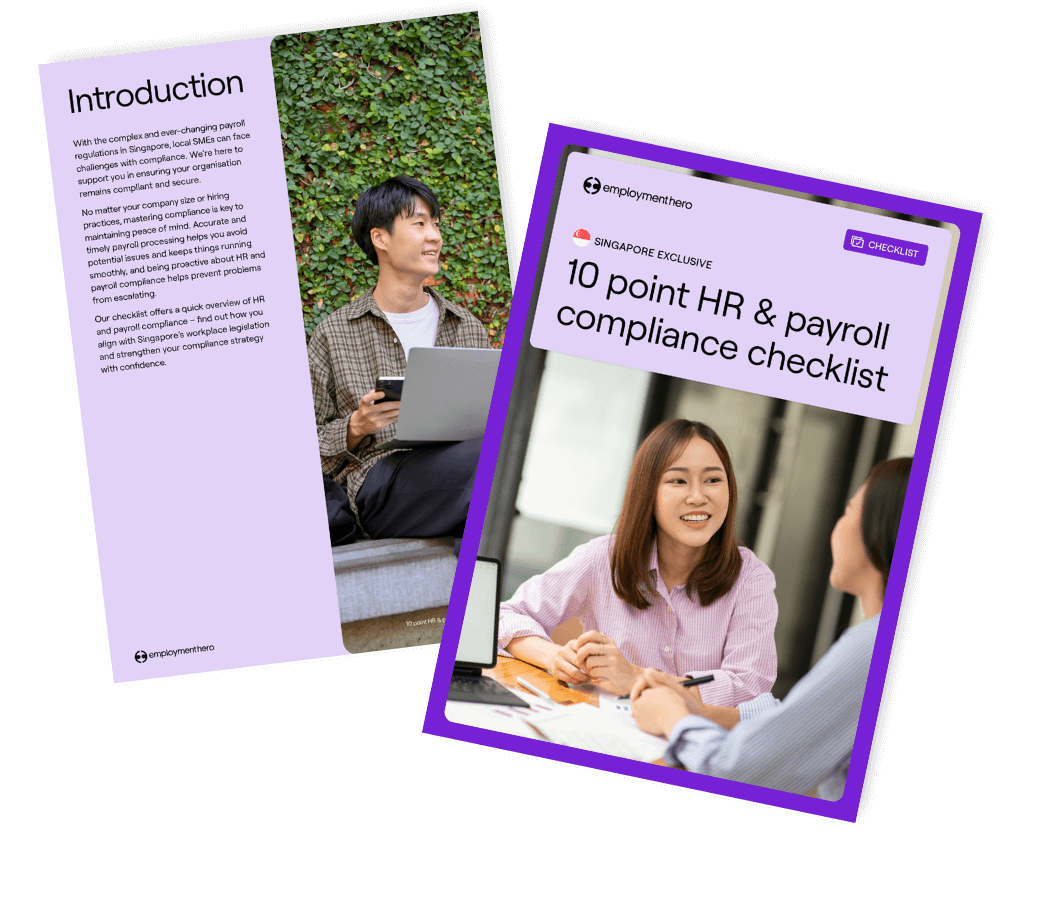Understanding Parental Leave in Singapore
Published
Understanding Parental Leave in Singapore
Do you know your obligations as an employer when it comes to maternity, paternity and shared parental leave in Singapore? There are various components and eligibility requirements involved which can be confusing, so we’re here to clear all your doubts.
In this parental leave factsheet, we cover;
- How does maternity leave and pay work?
- How does paternity leave and pay work?
- How does shared parental leave and pay work?
- What if working fathers and mothers don’t qualify for the government-paid leave schemes?
- How Employment Hero can help you manage employee leave more effectively
Download the factsheet now.
What is parental leave?
Parental leave allows parents to take time off from work to care for their newborn or newly adopted child. This provides them with precious time to bond with their child, support the wellbeing of both the parent and the child, and facilitate a smoother transition into parenthood.
Parental leave recognises the importance of the early stages of a child’s life and the significant role that parents play in their upbringing. It acknowledges that parents need time to adjust to their new responsibilities, establish a nurturing environment, and provide the necessary care and attention to their child.
Additionally, parental leave contributes to the overall wellbeing of families by reducing financial stress and ensures job security during their period of absence. It supports work-life balance and helps parents maintain a healthy integration of their personal and professional lives eventually.
Are there different types of parental leave?

Yes. In Singapore, there are four main types of parental leave — government-paid maternity leave, government-paid paternity leave, shared parental leave and adoption leave.
For working mothers and fathers or adoptive parents who may not qualify for the above due to their employment status, they will be eligible for government-paid maternity and paternity benefits instead of leave.
Apart from that, there’s also unpaid infant care leave and government-paid childcare leave.
You can find out more about the different types of leave options here.
Who is entitled to government-paid paternity leave in Singapore?
Eligible working fathers, including those who are self-employed, are entitled to 2 weeks of Government-Paid Paternity Leave (GPPL), as long as they fulfil the following criteria:
- The child is a Singapore citizen.
- They are or have been lawfully married to the child’s mother between conception and birth.
- For employees: they have served their employer for a continuous period of at least 3 months before the birth of their child.
- For self-employed: they have been engaged in a particular trade, business, profession or vocation for at least 3 continuous months before the birth of their child, and have lost income during the paternity leave period.
Working fathers with stillbirths are eligible for government-paid paternity leave, as long as they fulfil the following criteria:
- If the child’s mother was a Singapore citizen at the time of the stillbirth, they have to be lawfully married to the child’s mother at some point between conception and stillbirth (whether or not such marriage remains at the time of stillbirth); or within 12 months from the stillbirth (inclusive of date of stillbirth).
- If the child’s mother was not a Singapore citizen at the time of the stillbirth, the child’s father has to be a Singapore citizen at the time of the stillbirth, and be lawfully married to the child’s mother at some point between conception and stillbirth (whether or not such marriage remains at the time of the stillbirth).
- For employees: they have served their employer for a continuous period of at least 3 months before the date of the stillbirth.
- For self-employed: they have been engaged in a particular trade, business, profession or vocation for at least 3 continuous months before the date of stillbirth, and have lost income from ceasing to be actively engaged during the paternity leave period.
- There is a Notification of a Stillbirth certified by a medical practitioner or a registered midwife, or a stillbirth certificate issued by the Immigration and Checkpoints Authority.
Adoptive fathers who meet the following requirements are entitled to 2 weeks of government-paid paternity leave, (but from Jan 2024 onwards this will be doubled to 4 weeks):
- They are not the natural father of the child.
- The adopted child is a Singapore citizen. If the child is not a Singapore citizen, either the father or his wife (if she is a joint applicant to the adoption) has been a Singapore citizen since the date of issue of the dependent pass.
- For employees: they have served their employer for a continuous period of at least 3 months before the date of formal intent to adopt.
- For the self-employed: they have been engaged in their work for a continuous period of at least 3 months before the date of formal intent to adopt, and have lost income during the paternity leave period.
For working fathers with a non-Singapore citizen child, they will not be eligible for government-paid paternity leave. However, if they meet all other eligibility criteria, and their child obtains Singapore citizenship within 12 months from their date of birth, they will be eligible for paternity leave.
Are maternity leave start dates flexible?

For working mothers who are eligible for 16 weeks of maternity leave, the first 8 weeks must be taken in one continuous block. The maternity leave start dates must be either:
- 4 weeks before the child’s date of birth;
- No earlier than 28 days before the child’s date of birth; or
- From the child’s date of birth with mutual agreement between employer and employee.
The subsequent 8 weeks can be taken in one continuous block immediately after the first 8 weeks, or taken non-continuously with mutual agreement between employer and employee.
The end date must also not be any later than 12 months from the child’s date of birth (inclusive of date of birth).
Can employees resign during maternity leave?
Yes, employees in Singapore can resign during maternity leave if they choose to do so, but they cannot use their maternity leave to shorten their notice period.
Employees can however, use their maternity leave during the notice period — the period which they are on maternity leave will count towards their service of the notice period.
All maternity leave entitlements not used before their last day of employment will be forfeited.
How can employers better support working parents?

Creating a more inclusive and family-friendly workplace can go a long way in supporting working parents, who are struggling to balance their personal and professional responsibilities and obligations. Here are some ways you can provide support:
- Implement flexible work arrangements: remote working can be extremely helpful in empowering parents to balance their personal and work commitments. Having this flexibility gives parents more time in the day for parenting duties, since they don’t have to spend time commuting. If a child is sick and needs to stay home from school, parents can work from home as well instead of being forced to take leave.
- Be an empathetic leader: put yourself in your employee’s shoes and think about how you would feel if you had a sick child at home whilst struggling with a heavy workload? What would you need the most from your manager? What are some simple actions you can take that could make a difference? Whether it’s reshuffling priorities or easing their stress by taking off some of their workload, having empathy is critical in the workplace.
- Celebrate parenthood at work: focus on building a culture where employees are encouraged, not discriminated against, to care for their families. All milestones deserve to be celebrated — regardless of whether it’s pregnancies, a baby’s arrival, a child’s birthday, or an achievement they’ve made in school.
- Make parental leave policies and benefits clear and accessible: new parents are completely fresh to the game, so they can be unaware of what their rights are when it comes to parental leave and benefits. Make sure your company policies clearly state the protections and obligations of both the employer and employee, and that they can access it easily at any time.
- Provide childcare assistance: providing or subsidising childcare services, or partnering with local childcare centres to offer discounted rates for employees can go a long way in alleviating the financial burden of childcare expenses, and ensure your employees and their children have access to quality care.
- Establish private spaces for new mothers: having dedicated spaces for nursing mothers to express breast milk in privacy and comfort is crucial. Provide necessary equipment such as breast pumps, refrigeration facilities, and flexible break times to accommodate breastfeeding or pumping needs.
- Create parental support networks: community is everything — encouraging the formation of employee resource groups or support networks for working parents provides a platform for sharing experiences, tips, and resources. These networks can offer emotional support and help parents navigate the challenges of balancing work and family life.
- Provide access to an Employee Assistance Program (EAP): An EAP offers counselling services, resources, and referrals to support the mental health and wellbeing of working parents. This can include assistance with parenting challenges, work-life balance, stress management, and other related issues.
Employment Hero can help you manage employee leave more effectively
With so many types of employee leave available — maternity leave, paternity leave, shared parental leave, adoption leave, compassionate leave and more, it can get overwhelming to keep track of all your employees’ leave entitlements and dates.
But managing leave doesn’t have to be complicated or confusing. All you need is a great HR software that does the work for you while you reap the benefits of structure, efficiency and productivity. Employment Hero does all that and more for you and your business!
Say goodbye to mindless admin work — you’ll never be short-staffed again or lose leave requests again. With our platform, you’ll get notified whenever someone from your team requests for leave. You’ll be able to see all your team’s leave requests in a calendar view, see every employee’s leave balance, approve or decline requests with notifications automatically sent to your employee, and have a central digital source of truth for all employee leave documentation.
Plus you can access the platform anytime, anywhere straight from your mobile device. It’s leave management made easy.
Download our SG parental leave factsheet now.
Related Resources
-
 Read more: Everything You Need to Know About the Start Digital Grant Under the NCSS TechAndGO! Initiative
Read more: Everything You Need to Know About the Start Digital Grant Under the NCSS TechAndGO! InitiativeEverything You Need to Know About the Start Digital Grant Under the NCSS TechAndGO! Initiative
Discover the Start Digital Grant under NCSS’s TechAndGO! initiative.
-
 Read more: 10 point HR and payroll compliance checklist
Read more: 10 point HR and payroll compliance checklist10 point HR and payroll compliance checklist
Get peace of mind with our 10 point HR and payroll compliance checklist.









